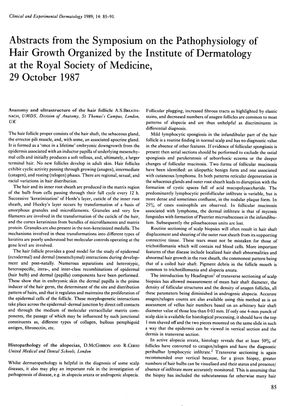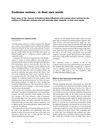Abstracts from the Symposium on the Pathophysiology of Hair Growth Organized by the Institute of Dermatology at the Royal Society of Medicine, 29 October 1987
January 1989
in “
Clinical and Experimental Dermatology
”
hair follicle alopecia hair keratin melanin dermal papilla hair growth cycle transverse sectioning scalp biopsy tyrosinase cAMP alopecia areata scarring alopecia lichen planopilaris discoid lupus erythematosus auto-antibodies systemic diseases minoxidil lysyl hydroxylase skin fibroblasts collagen production Rogaine

TLDR The symposium concluded that hair growth involves complex processes, including the hair follicle life cycle, the role of the dermal papilla, hair strength, pigmentation, and the impact of diseases and treatments like minoxidil on hair and skin.
The document summarizes findings from a symposium on hair growth pathophysiology, discussing hair follicle anatomy, alopecia histopathology, hair keratin structure, and melanin production. It highlights the hair follicle's life cycle, the dermal papilla's role in hair development, and the cyclic nature of hair growth. Different alopecias' histopathological features are detailed, including the benefits of transverse sectioning in scalp biopsies and the complexity of hair keratin in hair strength. The regulation of hair pigmentation is also explored, emphasizing the role of tyrosinase and cAMP. Specific alopecia types like alopecia areata, scarring alopecia, and the differentiation between lichen planopilaris and discoid lupus erythematosus are discussed. A study on alopecia areata involving 38 females and 28 males showed a higher association of auto-antibodies in females. The effects of systemic diseases on hair and the role of minoxidil in suppressing lysyl hydroxylase activity in skin fibroblasts were also presented, suggesting potential benefits for skin conditions with excessive collagen production.

